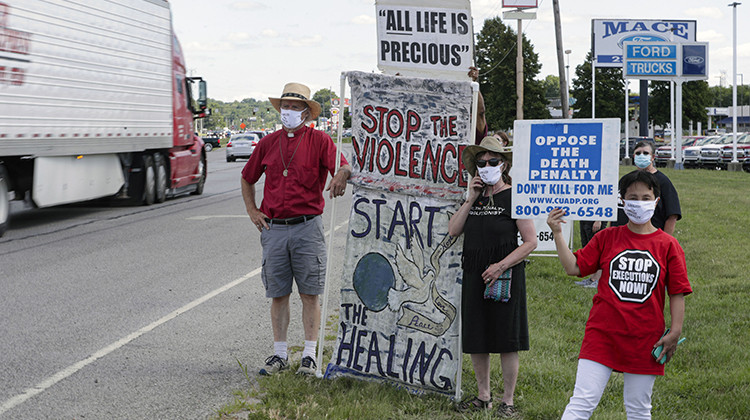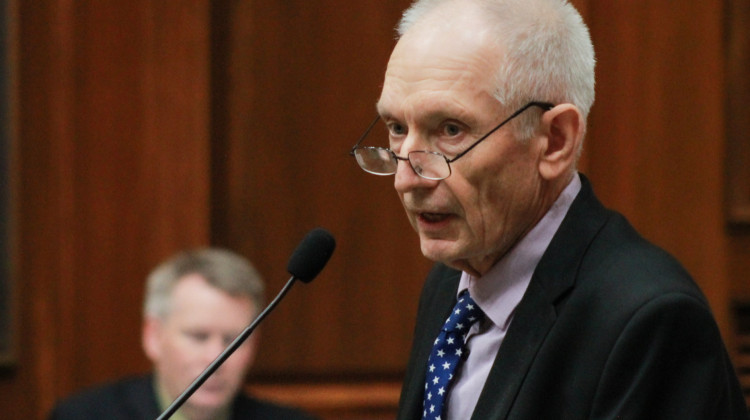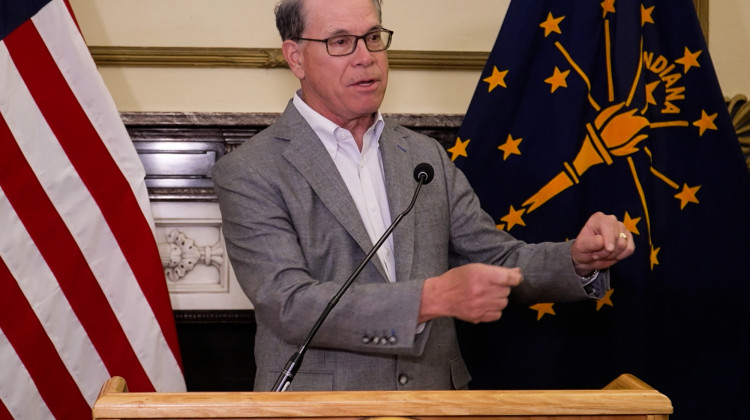
Protesters against the death penalty gather in Terre Haute, Ind., Monday, July 13, 2020. Daniel Lewis Lee, a convicted killer, was executed Tuesday morning in the federal prison in Terre Haute. He was convicted in Arkansas of the 1996 killings of gun dealer William Mueller, his wife, Nancy, and her 8-year-old daughter, Sarah Powell.
AP Photo/Michael ConroyMICHAEL BALSAMO - Associated Press
TERRE HAUTE, Ind. (AP) — The federal government on Tuesday carried out its first execution in almost two decades, killing by lethal injection a man convicted of murdering an Arkansas family in a 1990s plot to build a whites-only nation in the Pacific Northwest.
The execution of Daniel Lewis Lee came over the objection of the victims’ relatives and following days of legal wrangling and delays.
Lee, 47, of Yukon, Oklahoma, professed his innocence just before he was executed at the federal prison in Terre Haute, Indiana.
“I didn’t do it," Lee said. “I’ve made a lot of mistakes in my life, but I’m not a murderer.”
His final words were: "You’re killing an innocent man.”
The decision to move forward with the first execution by the Bureau of Prisons since 2003 -- and two others scheduled later in the week — drew scrutiny from civil rights groups and the relatives of Lee’s victims, who had sued to try to halt it, citing concerns about the coronavirus pandemic. The pandemic has killed more than 135,000 people in the United States and is ravaging prisons nationwide.
Critics argued the government was creating an unnecessary and manufactured urgency for political gain.
One of Lee's lawyers, Ruth Friedman, said it was “shameful that the government saw fit to carry out this execution during a pandemic."
“And it is beyond shameful that the government, in the end, carried out this execution in haste," Friedman said in a statement.
The developments are likely to add a new front to the national conversation about criminal justice reform in the lead-up to the 2020 elections.
The execution of Lee, who died at 8:07 a.m. EDT, went off after a series of legal volleys that ended when the Supreme Court stepped in early Tuesday in a 5-4 ruling and allowed it to move forward.
Attorney General William Barr has said the Justice Department has a duty to carry out the sentences imposed by the courts, including the death penalty, and provide closure to the victims and those in the communities where the killings happened.
But relatives of those killed by Lee in 1996 opposed that idea and argued Lee deserved life in prison. They wanted to be present to counter any contention the execution was being done on their behalf.
“For us it is a matter of being there and saying, 'This is not being done in our name; we do not want this,’” relative Monica Veillette said.
They noted Lee’s co-defendant and the reputed ringleader, Chevie Kehoe, received a life sentence.
Kehoe, of Colville, Washington, recruited Lee in 1995 to join his white supremacist organization, known as the Aryan Peoples’ Republic. Two years later, they were arrested for the killings of gun dealer William Mueller, his wife, Nancy, and her 8-year-old daughter, Sarah Powell, in Tilly, Arkansas, about 75 miles northwest of Little Rock.
At their 1999 trial, prosecutors said Kehoe and Lee stole guns and $50,000 in cash from the Muellers as part of their plan to establish a whites-only nation.
Prosecutors said Lee and Kehoe incapacitated the Muellers and questioned Sarah about where they could find money and ammunition. Then, they used stun guns on the victims, sealed trash bags with duct tape on their heads to suffocate them, taped rocks to their bodies and dumped them in a nearby bayou.
A U.S. District Court judge put a hold on Lee’s execution on Monday, over concerns from death row inmates on how executions were to be carried out, and an appeals court upheld it, but the high court overturned it. That delay came after an appeals court on Sunday overturned a hold put in place last week after the victims’ relatives argued they'd be put at high risk for the coronavirus if they had to travel to attend the execution.
Lee's execution was then set to happen at 4 a.m. EDT, but a last-minute legal question was raised by his lawyers. The Justice Department said it filed a request with the court to straighten it out but went through with the execution.
A U.S. marshal lifted a black telephone inside the execution room -- a small square room inside the prison with green tiles and windows looking at the witness rooms -- and asked if there was anything to impede the execution. He said there was not and the execution could proceed.
Lee had a pulse oximeter on a finger of his left hand, to monitor his oxygen level, and his arms, which had tattoos, were in black restraints. The IV tubes were coming through a metal panel in the wall.
He breathed heavily before the drug was injected and moved his legs and feet. As the drug was being administered, he raised his head to look around. In a few moments, his chest was no longer moving.
Lee was in the execution chamber with two men the Bureau of Prisons identified as “senior BOP officials,” a U.S. marshal and his spiritual adviser, described by a prisons spokesperson as an “Appalachian pagan minister.” They and Lee didn't wear masks.
One of the senior prisons officials in the room announced Lee’s time of death, and the curtain closed.
Two other federal executions are scheduled for this week, though one remains on hold in a separate legal claim.
There have been two state executions in the U.S. since the pandemic forced shutdowns nationwide in mid-March — one in Texas and one in Missouri, according to the Death Penalty Information Center. Alabama had one in early March.
Executions on the federal level have been rare, and the government has put to death only three defendants since restoring the federal death penalty in 1988 — most recently in 2003, when Louis Jones was executed for the 1995 kidnapping, rape and murder of a young female soldier.
Though there hadn’t been a federal execution since 2003, the Justice Department has continued to approve death penalty prosecutions and federal courts have sentenced defendants to death.
In 2014, following a botched state execution in Oklahoma, President Barack Obama directed the Justice Department to conduct a broad review of capital punishment and issues surrounding lethal injection drugs.
The attorney general said last July the review had been completed, allowing executions to resume. He approved a new procedure for lethal injections that replaces the three-drug combination previously used in federal executions with one drug, pentobarbital. This is similar to the procedure used in several states, including Georgia, Missouri and Texas.
Numbers of state executions have fallen steadily since the 2003 federal execution, according to data compiled by the Death Penalty Information Center. States put to death 59 people in 2004 and 22 in 2019.
Associated Press writers Mark Sherman and Colleen Long in Washington and Michael Tarm in Chicago contributed to this report.
 DONATE
DONATE








 Support WFYI. We can't do it without you.
Support WFYI. We can't do it without you.